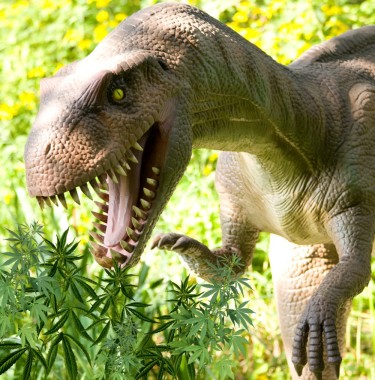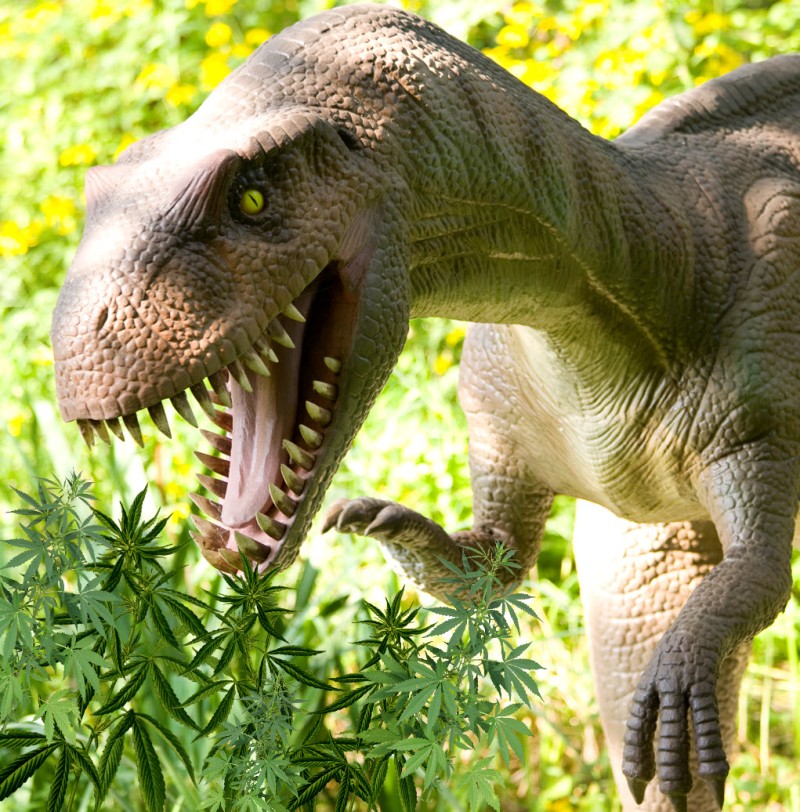
10 Crazy Uncommon Facts About Cannabis
Okay folks, today let’s go down a rabbit hole of strange. You love weed, but I’m sure you won’t know all of these uncommon facts about cannabis. Out of the 10, how many of these did you know?
Let’s go!
Cannabis and Dinosaurs:
The discovery of fossilized cannabis pollen dating back to the late Cretaceous period, approximately 70 million years ago, has sparked intriguing questions about the historical relationship between cannabis and dinosaurs. The finding not only indicates the ancient existence of cannabis plants but also raises the possibility of dinosaurs interacting with the plant in some manner.
While it is impossible to determine the exact nature of the interaction between dinosaurs and cannabis, scientists speculate that some herbivorous dinosaurs might have consumed parts of the cannabis plant as part of their diet. It is well-established that certain animals seek out and consume plants with medicinal properties, which raises the intriguing possibility that dinosaurs may have instinctively sought cannabis for its potential therapeutic or nutritional benefits.
This discovery offers a glimpse into the ancient ecosystem and the role of cannabis in prehistoric environments. It sheds light on the plant's resilience and adaptability, having survived and evolved over millions of years. The knowledge that cannabis has ancient roots, possibly extending back to the time of the dinosaurs, adds another layer of fascination to the storied history of this remarkable plant.
The First Item Sold Online Was a Bag of Weed:
The historic cannabis transaction between students at the Stanford Artificial Intelligence Laboratory and those from the Massachusetts Institute of Technology (MIT) in 1971 holds a place of significance in the evolution of online commerce. At that time, the concept of the internet as we know it today was still in its infancy, with ARPANET serving as a pioneering network that laid the groundwork for future technological advancements.
This first-ever online transaction was not only a novelty but also a bold demonstration of how the internet could be used for commercial purposes. While the exchange of cannabis may have been unconventional and likely illegal, it inadvertently set a precedent for the future of e-commerce, offering a glimpse into the boundless possibilities of a digitally interconnected world.
George Washington and Cannabis Farming:
George Washington's enthusiasm for cannabis cultivation extended far beyond being a hemp farmer; it was a reflection of his progressive and visionary mindset. He approached hemp farming with a genuine curiosity, conducting numerous experiments to identify the best cultivation techniques and strains. Washington's meticulous record-keeping showcased his commitment to the plant's potential economic and industrial value.
Washington firmly believed that hemp could be a transformative crop for the fledgling nation. Recognizing its versatility, he saw hemp as a valuable resource for producing various essential products, including textiles, paper, and ropes. In a letter to his friend and fellow farmer, James Madison, Washington wrote about his desire to see hemp "extolled beyond all other crops." He understood that cultivating hemp could help the country become more self-reliant, reducing its dependence on imported goods.
The First Bong Was Made from Gold:
The ancient history of bongs reveals a fascinating and culturally significant connection between cannabis and human societies. The Scythian tribal cultures of ancient Russia and China were pioneers in the art of bong-making, using these devices to consume cannabis in ritualistic ceremonies and communal gatherings.
The first-ever bong discovered, made from solid gold, provides a glimpse into the opulence and reverence associated with cannabis use in these ancient cultures. Elaborate engravings and intricate designs on the bong suggest that it was not merely a utilitarian tool but a symbol of spiritual and social significance.
In these ancient civilizations, cannabis held a revered place, believed to facilitate communication with the divine and serve as a conduit for altered states of consciousness. The bong, with its ability to cool and filter the smoke, was likely considered a vessel through which the essence of the plant could be harnessed and revered.
Cannabis as Bioremediation:
The practice of using cannabis for phytoremediation, or environmental cleanup, has shown remarkable potential in various polluted regions worldwide. Beyond Chernobyl, cannabis has been deployed to address contamination caused by industrial activities, mining, and even areas affected by oil spills. This natural cleansing process relies on the plant's unique ability to absorb and accumulate harmful substances within its tissues, effectively filtering the soil and air.
The application of cannabis in phytoremediation not only mitigates environmental damage but also contributes to sustainable land rehabilitation. Cannabis plants play a pivotal role in transforming polluted sites into habitable and productive areas, benefiting both the ecosystem and nearby communities.
Researchers continue to explore the full extent of cannabis' phytoremediation capabilities, aiming to identify strains with heightened pollutant-absorbing properties. The potential of cannabis as an eco-friendly tool for environmental restoration remains an exciting area of study, offering hope for a greener and cleaner future. As we continue to grapple with environmental challenges, cannabis' contribution to phytoremediation stands as a testament to the plant's versatility and its ability to serve humanity in diverse and unexpected ways.
The Largest Joint Ever Rolled:
In 2012, at the Cannabis Cup in Amsterdam, a group of dedicated enthusiasts rolled the largest joint ever recorded, measuring an astonishing 109 feet and 7 inches long. It took a team of people and hundreds of pounds of cannabis to create this record-breaking joint, which was smoked and enjoyed by the crowd at the event.
Thomas Jefferson's Cannabis Cipher:
Thomas Jefferson's coded letters, laced with references to cannabis cultivation and its uses, provide a unique glimpse into the more private aspects of his life. His clever use of encryption allowed him to openly discuss his passion for the plant while maintaining a level of discretion necessary during that time. These coded messages not only highlight Jefferson's interest in cannabis but also reveal the prevalence of the plant in early American society.
Jefferson's affinity for cannabis extended beyond mere curiosity; he recognized its potential as a valuable agricultural commodity. In one of his encrypted letters, he discussed the different varieties he cultivated, indicating his dedication to understanding and improving the plant's traits. Moreover, he expressed his fascination with cannabis' versatility, contemplating its potential uses in textiles, paper, and even medicine.
The Cannabis DNA Sequence Was Mapped in Space:
In 2016, scientists from the University of California, Davis, successfully sequenced the entire DNA of the cannabis plant aboard the International Space Station. The experiment aimed to study the effects of microgravity on the plant's development and genetic expression. This groundbreaking research may lead to advancements in cannabis cultivation and understanding its potential for space agriculture.
The First U.S. Flag Made from Hemp:
The first American flag, sewn by Betsy Ross at the request of George Washington, was made from hemp fibers. Hemp was an essential crop in early American history, and its versatility made it an ideal material for various products, including textiles like the first flag of the United States.
Cannabis as a Sustainable Building Material:
Cannabis has recently garnered attention for its potential as a sustainable building material. Hempcrete, a bio-composite made from the woody core of the hemp plant, is lightweight, durable, and carbon-negative. It offers excellent insulation properties and has the potential to revolutionize the construction industry by providing a more eco-friendly alternative to traditional building materials.
So there you go…how many out of 10 did you get correct?
MORE FUN FACTS ABOUT CANNABIS, READ ON...
6 FUN FACTS ABOUT THC YOU DIDN'T KNOW UNTIL NOW!







